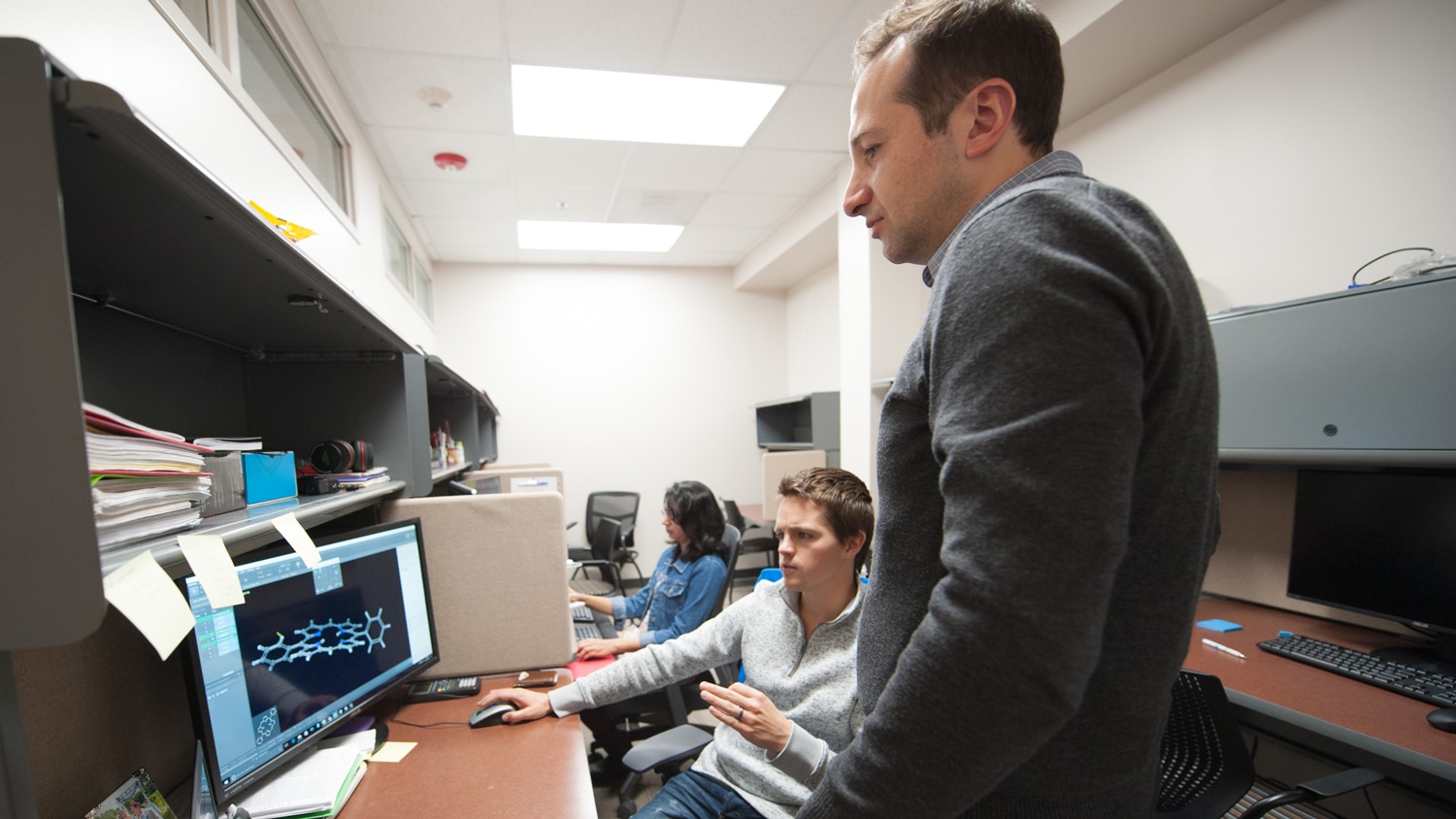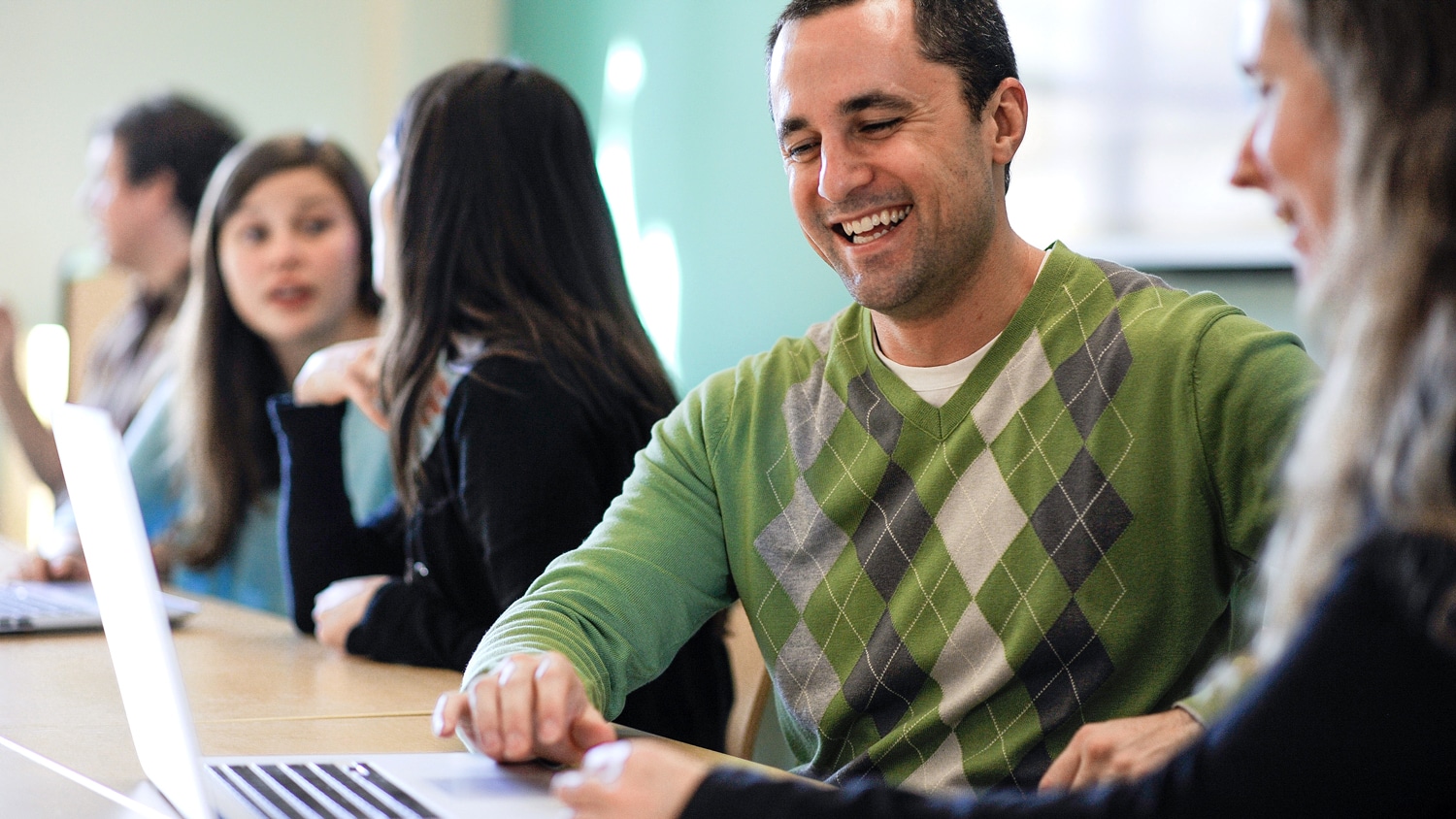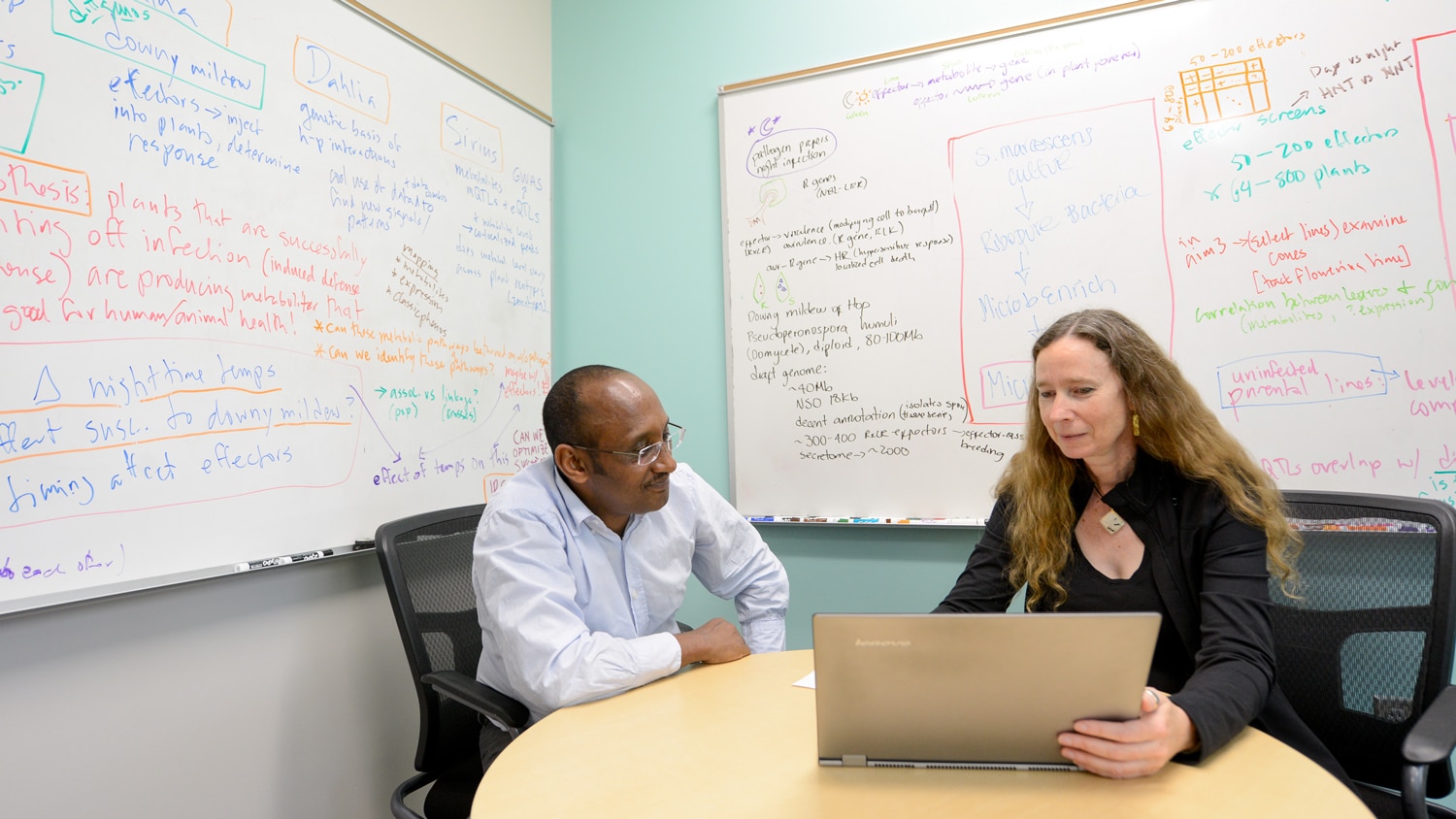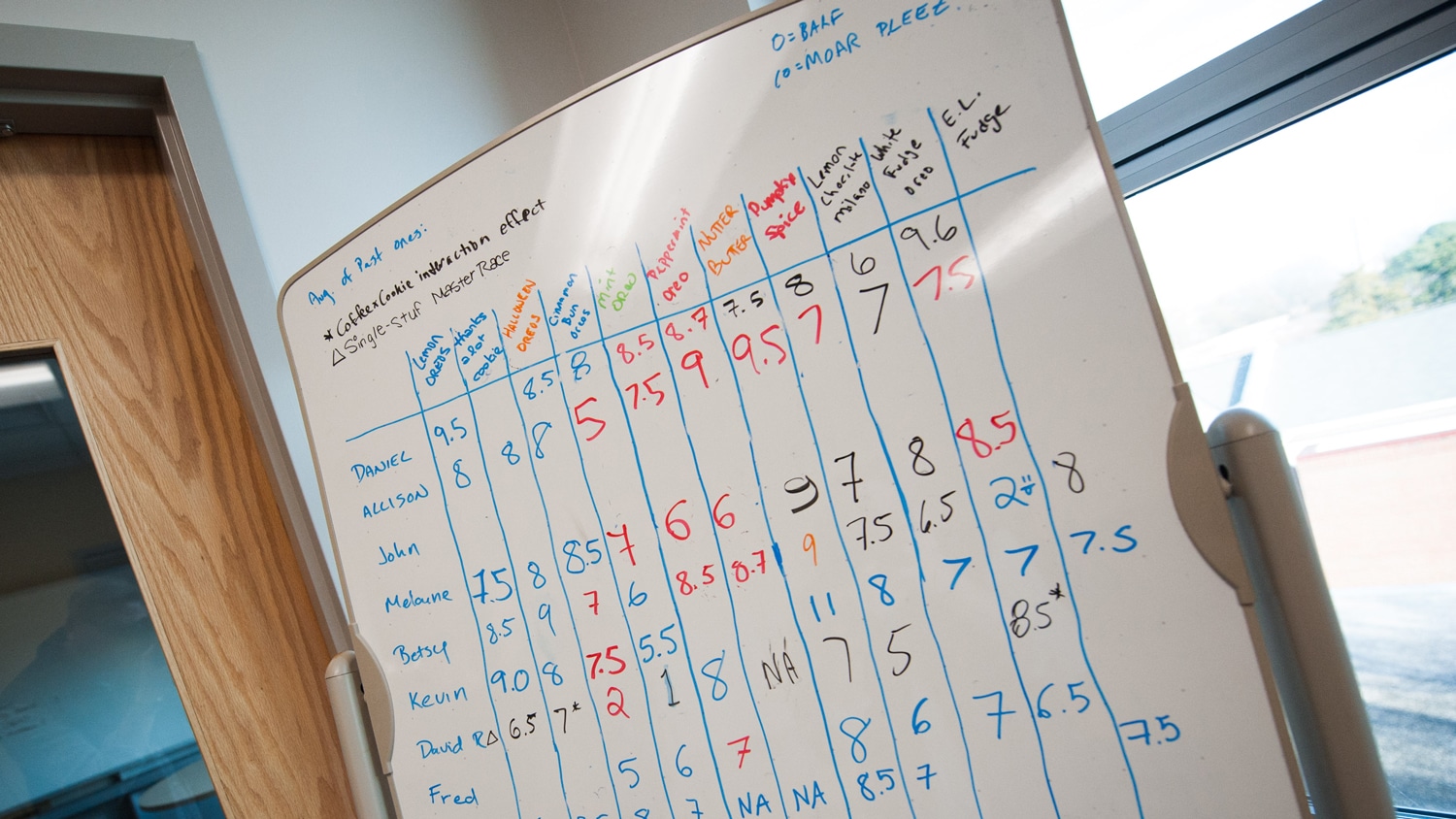When toxicologist David Reif needs a fresh perspective on his work, he doesn’t have to walk across campus. Or join a Skype call. Or even send an email.
Since he’s part of NC State’s Bioinformatics faculty cluster, he can just walk down the hall. “The barrier to asking questions is essentially zero,” Reif said.
Like others in this interdisciplinary field, Reif studies biological problems through data. The cluster is made up of four faculty — Fred Wright, Denis Fourches, Dahlia Nielsen and Reif — who work alongside other professors, graduate students, postdoctoral researchers and support staff in diverse scientific fields such as genetics, statistics, chemistry and biology.
http://oembed.tarheelcode.io/modules/2
They’re solving problems that affect everyone, like toxic chemicals’ effects on our bodies and how genetics influences our bodies’ response to these effects. These problems span traditional academic department boundaries, so pooling expertise means more answers for all.
The Bioinformatics cluster is part of NC State’s groundbreaking Chancellor’s Faculty Excellence Program, which aims to put faculty together, both physically and intellectually, to combine ideas and experience in ways that solve big problems. These researchers are showing that when you put brilliant minds from different areas of science in one place, new partnerships that lead to groundbreaking discoveries are forged around shared conference tables, in chance hallway encounters, over cookie breaks or even during movie nights.
Bridging the Gaps
Faculty clusters and interdisciplinary work have become hot topics in higher education around the world, but this“new” interdisciplinary approach has actually permeated science for centuries. Ancient Greek philosophers sought to understand the world by amassing knowledge in many different areas, including metaphysics, logic and biology. The cluster model mimics groups like the Royal Society, established in London in the 17th century by astronomer and architect Sir Christopher Wren to bring together sharp minds from across the scientific spectrum.
NC State’s program, focusing on assembling groups of faculty with complementary areas of expertise to study interdisciplinary research challenges, was one of the first major initiatives Chancellor Randy Woodson announced after coming to the university in 2010. Since the program’s launch in 2011, NC State has hired nearly 60 faculty in 20 cluster areas. The College of Sciences has the largest number of cluster faculty of any college, with 14.

The well-regarded program has spurred development of new graduate academic programs and generated partnerships with government and industry. It’s also a key tool for recruiting top graduate students and faculty — especially those with research interests and backgrounds that don’t align with traditional academic departments.
“The cluster program was a way for me to see a fit for myself here,” said Reif, who came to NC State from the Environmental Protection Agency. “It was exciting that they wanted people who are good at different things to bridge across disciplines and come together.”
Getting Closer
The Bioinformatics cluster grew out of the university’s Bioinformatics Research Center, which was one of the first centers in the nation to embrace bioinformatics as its own discipline.

As cluster faculty were hired and the center grew, it needed a new home where faculty could work alongside one another and have access to the academic heart of campus. So the university worked with the faculty to renovate the third floor of Ricks Hall, a stately yellow brick building adjacent to Hillsborough Street. The goal was to create a mix of open and private spaces where faculty and students could work separately or together.
“Team science is very important here,” said Wright. “So we needed a layout to foster that kind of work.”
At the heart of the floor are two large collaborative spaces: a conference room and a lounge. These are places to gather for everything from formal presentations to brainstorming meetings to movie nights.
Elsewhere, offices and smaller shared workspaces give individuals or small groups some separation, while keeping them close enough to others to allow easy exchange of questions and ideas. The proximity to College of Sciences buildings, D.H. Hill Library and the creative culture of Hillsborough Street adds to the space’s appeal.
“Because we were able to fully participate in the design phase, we could create a work space best suited to the cluster’s needs,” said David Bird, William Neal Reynolds Distinguished Professor in the Department of Entomology and Plant Pathology, and the cluster’s coordinator. “It’s an atmosphere that encourages collaboration and enables our best work.”
Answers Across the Hall
http://oembed.tarheelcode.io/modules/4
Why, in this age of near-instant electronic communication, is being able to easily pop into someone’s office still important? Recent research has shown that when low-cost airfares are available in pairs of cities where scientific collaborators are located, they collaborate almost 50 percent more often. And it’s even easier to collaborate when you don’t have to leave your building. A walk to the bathroom or refrigerator can mean you run into a colleague who can help you think about your work in a new way.
“Being together in the same building has been a game changer for this cluster,” Fourches said. “Since we are not spread out all over campus, we can have collaborations that are quicker and more successful.”
Nielsen’s office is directly across the hall from Reif’s, which makes it especially easy for them to interact frequently and mesh their different, but complementary, areas of expertise. That could mean consulting on a journal article or brainstorming experiments over a cup of coffee.
“He had a grant proposal he had to turn in, and he asked me to read over it,” Nielsen said. “The people in his field know his research very well, whereas I know what he does, but I don’t know the details of it. So I can read through it and point out places where he needs to explain things better to people who don’t have an inside perspective.”
This proximity and easy access to other perspectives also benefits the students, who gain knowledge and experience that inform their current work and boost their résumés for the future.
“When you go to the graduate student area, you see a chemist next to a toxicologist working on the same data set with two different perspectives,” Fourches said. “That is unique. I haven’t seen it anywhere else in the country.”
Chemicals, Cells and Cookies
Being able to regularly share ideas with other researchers in the cluster setting has both shaped the Bioinformatics team’s existing work and inspired new projects.
“I had ideas beforehand about how genetic variation might affect how individuals respond to chemicals,” Reif said. “But being here around statistical geneticists has helped me add some rigorous science to those ideas, so now I can test them to see if those hypotheses are true.”
One project Reif has worked on with Wright, a statistical geneticist, is an Environmental Protection Agency-funded study of the effects of toxic environmental substances on human health, and particularly the heart. This work could open up future research possibilities for testing individuals’ responses to toxicity.

Both Reif and Fourches have also individually studied nanomaterials, with Reif focusing on their biological impact and Fourches researching them from a chemical angle. Now the two are bringing together their individual perspectives to develop new methods for determining how properties like size and reactivity affect these tiny materials’ potential impacts on human health and the environment.
The cluster also engages in research that is a bit less serious, though no less scientifically rigorous. A whiteboard in one of the small conference rooms displays a grid where faculty and students list their numerical ratings for various cookies provided for sampling. Their statistical bent comes out in ratings with decimal points and controls for the “coffee x cookie interaction effect.”

The cookie rating is just one way that the cluster builds community, which is key to creating an atmosphere where people feel comfortable openly exchanging ideas — and also one in which they enjoy coming to work. Whiteboards in the hallway display hand-drawn cartoons and event announcements, and a jigsaw puzzle of donuts sits on the coffee table in the lounge, where graduate students often gather on evenings or weekends to watch sports or movies. An espresso machine in Reif’s office attracts those in need of a caffeine fix, and Nielsen frequently holds meetings at the table in her office that result in controlled chaos on her two large whiteboards.
“I learn so much from my colleagues every day, and I also really enjoy being around them,” Nielsen said. “It’s a great place to work.”
This post was originally published in College of Sciences News.